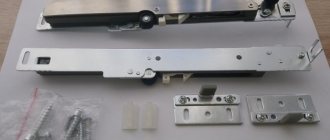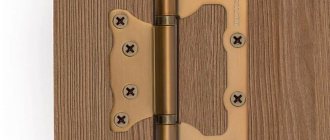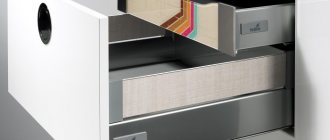Manufacturers of modern household appliances for the home, and in particular the kitchen, devote all their efforts to creating comfortable-to-use, economical and, most importantly, compact models of dishwashers, refrigerators, ovens and even microwave ovens. It is the latter representative that we will talk about today, telling you how to correctly install a built-in microwave oven and connect to the network with your own hands. The instructions are simple and will not take you more than 5 minutes, so we recommend that you read them carefully!
Pros and cons of a built-in microwave oven
When choosing household appliances, you should always start from the advantages or disadvantages that the housewife will encounter after purchasing this device. Models of different types have significant differences that affect their characteristics, method of installation in the room, and maintainability. First, let's describe the undoubted advantages of a built-in microwave oven:
- These devices have an impressive working chamber; in most cases, they are comparatively larger in depth and thinner in the upper part.
- A built-in microwave takes up less work space.
- The walls of the furniture set provide greater protection from radiation.
- The device hidden behind the facade is better protected from debris, dust, and accidental mechanical damage.
- Household appliances of this type stand out less in the interior.
- Connection wires do not interfere with work and movement in the kitchen.
- Integrated ovens are easier to install at chest level so you don’t have to bend over when cooking.
Disadvantages of built-in microwaves:
- Moving the device to another place without remodeling the façade of the kitchen furniture is problematic.
- The range of these ovens is relatively smaller compared to independent type appliances.
- The cost of integrated devices is higher.
- Freestanding models are easier to clean than built-in ovens.
What type of microwave oven to choose
Microwaves are much smaller than refrigerators, but they always lack space.
When it comes to placement, it turns out that there is a shortage of free space in the kitchen. If you place the stove on the countertop, a portion of the working surface will be lost, which is unjustified in a cramped kitchen. There are also miniature models, but their capabilities are limited. If you want a microwave with different functions and auto modes, think in advance where to install it. If you have space in your kitchen cabinetry, it may be best to ditch the freestanding model in favor of a built-in one. This is a rational option that allows you to save space and fit your household appliance beautifully.
The installation method and location will depend on the type and dimensions of the equipment. If you buy a small model, it can be locked in a closet on any shelf.
All microwave ovens can be divided into:
- ordinary;
- small;
- built-in
The most successful accommodation options
There are several optimal ways to install a microwave oven, each of which has its own characteristics.
| Place | Installation Features |
| On the wall | One of the most successful and convenient accommodation options. Can be placed above a work surface or dining table. For this, special brackets are used. Ideally, the height at which the stove is placed should not be higher than chest level |
| On the tabletop | One of the most convenient places to place the device. Especially if it is located in the corner of the kitchen unit. This option allows you to adhere to all technical standards. The device does not take up much space |
| Dishwasher | Favorable placement, since the unit practically does not heat up and does not create vibrations. When installing, there must be a layer of thermal insulation between the devices. |
| Washing machine | The weight of the stove should not exceed 15 kg. A rubber mat must be installed under the washing machine. This will reduce vibrations and prevent possible slipping or falling of the microwave oven. |
| Windowsill | Installation on a window sill is possible if there is a blind window sash |
| Built-in oven | This option is not recommended due to the high risk of overheating of the microwave oven |
Be sure to read:
At what distance from the battery can you place a refrigerator?
How to install a microwave in the kitchen
When choosing kitchen appliances, including microwave ovens, consumers increasingly prefer more compact, easy-to-use models. Microwave ovens can be either free-standing or built-in – it’s up to you to decide which one to choose. But it’s better to choose a place for the equipment in advance. And based on this, you should select a model. We will tell you how to install a microwave oven and where it is best to place it. It is also important to know how to properly connect an electrical appliance so that it can be used conveniently and as safely as possible.
What types of microwave ovens are there?
Before moving directly to the installation stage, let's look at what microwave ovens exist. So:
- the simplest microwave ovens with a minimum set of functions (heating and defrosting);
- Microwave ovens with grilling function;
- models with a convection system that can easily replace your built-in oven.
Choosing a place for a microwave - basic rules
Most modern city apartments dating back to the period of Soviet development cannot be called spacious. As a rule, all household appliances are placed in them according to the simple principle “any free corner fits”. However, if you follow some rules, it is quite possible to correctly and functionally place all household appliances, including a microwave oven.
You should not install the microwave too low to the floor, as it will be very inconvenient to use. The distance between it and the floor should range from 0.6 to 1.5 meters. You should also not place the microwave oven too high, as you can easily get burned when taking out heated food.
It is necessary to calculate the height so that it is comfortable for all family members, both large and small. It is preferable that there is a tabletop nearby on which you can immediately place a hot plate.
It is undesirable for a microwave oven to be adjacent to heating appliances and an oven. It should not come into contact with the refrigerator. Do not install other household appliances (kettle, coffee maker) on the microwave oven. You need to make sure that the microwave door opens freely and does not hit any obstacles.
Other equipment
13. The dishwasher is not built in at all.
Few people know that a built-in dishwasher and just a dishwasher are essentially the same thing. The principle of installing this device is incredibly simple: just put it under the countertop, connect it and screw the decorative facade to the door. All! By the way, the dishwasher should not be located in the corner of the kitchen. You cannot attach a decorative facade to the sides of the device, and you will see the body of the device - not very aesthetically pleasing.
14. Built-in microwave – not always cool
Strictly speaking, this is, of course, wonderful and convenient. But in fact, most kitchen cabinet layouts involve an oven at a level of 80 cm from the floor, and above it - a microwave unit. And now imagine: a microwave oven at a level of one and a half meters from the floor. If everyone in your family is tall, this is normal. But for someone of short stature (for example, children), using it at such a height will not be very convenient. And pulling out a bowl of soup will be another test of dexterity.
You can, of course, say that for the last 10 years the microwave has been standing on top of the refrigerator - and nothing, they could reach it. But that’s not why a new kitchen is being made, is it to suffer? If you want to build in a microwave, think about its location.
15. You can embed everything
And finally. A modern kitchen is not limited to built-in hobs, ovens, hoods and refrigerators. You can also build in small household appliances: microwave ovens, coffee machines, steamers, juicers, grills. Even a vacuum cleaner! However, make sure that you really need all these devices. Otherwise, over time, they will literally leave empty space in the closet.
Basic rules for placement
Since you have to use a microwave oven often, you need to pay due attention to where it is placed. General requirements for placement:
General requirements for placement:
- optimal height from the floor – 60-150 cm;
- should not be placed near a stove, oven, radiator or other heating appliances;
- position it so that you can easily reach it with your hand;
- do not place the microwave oven next to the sink;
- make sure that nothing prevents the door from opening and closing;
- ventilation openings must not be blocked. They are usually located on the top panel. If particles of food or water get there, the device may burn;
- Do not store interior items or kitchen utensils on the appliance.
Ignoring advice on ergonomic and safe placement is not recommended. Due to improper use, the microwave oven will quickly break down, and if it is inconveniently positioned, you risk spilling hot food on yourself and getting burned.
How to install a microwave in the kitchen
When choosing kitchen appliances, including microwave ovens, consumers increasingly prefer more compact, easy-to-use models. Microwave ovens can be either free-standing or built-in – it’s up to you to decide which one to choose. But it’s better to choose a place for the equipment in advance. And based on this, you should select a model. We will tell you how to install a microwave oven and where it is best to place it. It is also important to know how to properly connect an electrical appliance so that it can be used conveniently and as safely as possible.
What types of microwave ovens are there?
Before moving directly to the installation stage, let's look at what microwave ovens exist. So:
- the simplest microwave ovens with a minimum set of functions (heating and defrosting);
- Microwave ovens with grilling function;
- models with a convection system that can easily replace your built-in oven.
Pros and cons of building in a microwave
The main advantage of built-in household appliances is saving space in the kitchen. A compact microwave oven is installed in a closet, pencil case, niche, occupying the entire space, leaving no useless idle areas. Other advantages of such ovens:
- Large volume. Despite their compactness, built-in microwaves are not inferior to conventional ones in internal dimensions. This allows you to heat food on large plates or place several dishes inside at once.
- Quality and functionality. Built-in models are produced for long-term use, which is why they have an extended service life and additional protection against overheating, moisture, and power failures. Since such microwaves are made only by popular brands for the high price segment, they are almost always equipped with a grill, convection, automatic doors, an improved display and other additional functions.
- Hygiene. The microwave completely occupies its niche, which eliminates the accumulation of dust and debris in the cabinet. Installation inside the cabinet will protect the internal gaps, cracks, and buttons of the stove itself from contamination, reducing the likelihood of breakdowns. All that is required from the owner is to periodically wipe the door frame of the device.
- Aesthetics. The integrated microwave merges with the facade of the kitchen, eliminates voids and cracks, does not spoil the appearance with wires, and therefore looks better in the interior. This stove fits especially well with a country or classic style design, where openly standing modern appliances look out of place.
Disadvantages of built-in microwaves:
- Difficulty of repair. If the stove fails, you will have to dismantle it to transport the device to a service center. The same problem will arise when moving or rearranging the interior - the need to remove and reinstall the microwave will waste extra time and effort.
- High price. With equal quality and functionality, built-in models are 20% more expensive than regular ones.
- Difficult to install. To install the stove, you will have to take your own measurements, buy fasteners, carry out ventilation, and ensure the connection of the device to the electrical network. For safety, it is recommended that two people work together. The alternative is to pay professionals for installation, but this will result in additional costs.
- Impossibility of replacement. Built-in stoves are unique in size, so it is impossible to install another model in the same niche. Due to the rapid change of lines, it will also be difficult to buy the same microwave. If the appliance malfunctions, you will have to change the interior of the kitchen or be content with a free-standing stove.
Problems with built-in microwaves arise from the inability to move them. If the appliance is placed poorly, this can create difficulties with cleaning, maintenance, and heating food, so you need to choose carefully.
Microwave cabinet: dimensions, location and choice of material
Dimensions
First, let's separate the flies from the cutlets.
There are two versions of microwave ovens, and each of them has its own requirements for the size and shape of the cabinet.
- The built-in microwave oven is installed in a cabinet without a back wall in the compartment for its installation. The rear wall above this compartment must be separated from the wall by a gap of at least 45-50 mm;
Captain Obviousness suggests: this requirement automatically makes it very problematic to install a built-in microwave in a wall cabinet.
- For a freestanding microwave oven, installation in a cabinet with a rear wall is permissible. In this case, the depth of the cabinet must be at least 100 mm greater than the corresponding dimensions of the stove, there must be a 150 mm gap on top, and gaps of at least 50 mm on the sides.
The size of the compartment must ensure free operation of ventilation
Hint: ventilation of the microwave working chamber can be organized either through the back wall, or through the top or side.
Location
The microwave oven must not be installed:
- Under the sink or boiler. A leak at any water supply or sewer connection (in the case of a boiler, the safety valve drain outlet) can lead to a short circuit and fire;
- Above the oven or stove. The rising flow of hot air will heat the stove to high temperatures that threaten to damage the insulation.
The microwave compartment is located away from the stove
In addition: when the microwave oven is located in the lower cabinet, next to the oven, its compartment must be additionally insulated with a heat-resistant material with low thermal conductivity (for example, multi-layer lavsan).
Materials
What is the best material to make a cabinet into which you plan to install a microwave oven?
Let's think for a moment about the conditions of its operation: the inner surface of the cabinet will be in contact with the air leaving the microwave chamber through the ventilation. This air is heated to 50-70 degrees and, when cooking in an open container, can have a relative humidity exceeding 100%.
Grate for extracting air from the microwave oven chamber
Hence the conclusion: the cabinet material must be resistant to fluctuations in temperature and humidity. What and to what extent meets these requirements?
Most inexpensive kitchens are made from laminated chipboard. She:
- Protected from moisture by a thin film of melamine resin;
- At the slightest damage to the lamination, it absorbs water like a sponge, losing the remnants of its already low mechanical strength;
- Swelling in water, it warps and increases in volume;
- When heated, it becomes a source of volatile phenolic compounds, since phenol-formaldehyde resin is used as a binder to glue chips into a slab.
Verdict: not suitable for making a cabinet for a microwave oven.
Consequences of contact of laminated chipboard with water
This material, like chipboard, is a wood processing product. Pressed under pressure and at high temperatures, cellulose fiber is glued together with harmless urea-melamine resins. MDF is less hygroscopic compared to chipboard, more durable (in particular, it holds screws much better) and does not poison the surrounding air when heated.
Verdict: suitable as a budget solution with an estimated service life of the cabinet of no more than 5-7 years.
Floor cabinet made of MDF
Furniture plywood
FC plywood is durable and harmless (including when heated). At temperatures up to 70-80°C, its shape and size remain unchanged. To reliably protect the surface of a plywood cabinet from moisture, you can use waterproofing paints (including water-based) and varnishes (urethane, alkyd and acrylic).
Verdict: provided the surface is waterproofed, it allows you to create kitchen furniture with an almost unlimited service life.
Stylish kitchen made of furniture plywood
Tips and warnings
When working with a built-in microwave oven, it is especially important to follow safety precautions and operating rules in order to maximize the service life of the device. Tips for important points:
Tips for important points:
Microwave oven maintenance should be carried out at least once every 2-3 months. During the procedure, you need to check the serviceability of all functions, wash the device, clean the ventilation holes, remove debris from the gaps, make sure the integrity of the case, internal coating, and electrical wires. For built-in models, ventilation care is especially important, since if the rules are not followed, a fire may occur. Microwaves are high-voltage equipment, so they need to be protected from voltage surges. To do this, it is worth providing the device with a separate outlet. Since the built-in model cannot be moved, it is worth installing it in advance, taking into account the length of the wire. It is not advisable to use extension cords, as well as to connect several plugs to one power source. Consider the nuances of placement. It is undesirable for it to be in proximity to a hob, water sources, windows, indoor plants (they do not tolerate radiation well), or meters (they can get lost under the influence of waves). It will be difficult to move the device after installation; check the kitchen plan and choose a convenient option. Before installing the equipment, you need to ensure easy access to the socket and cables
In case of breakdowns, fire, or short circuits, it is important to turn off the device as quickly as possible, which is not always possible with built-in models
Microwaves built into the cabinet help save space, look stylish, are reliable, and functional. Among their disadvantages are the high price, difficulty of repair, possible problems with installation, operation, and safety precautions. The appliances look best in small, high-tech kitchens. The convenience, feasibility, and service life of integrated microwave ovens depend on the location, so its selection must be approached especially carefully.
Why is it important to choose the right location?
It is important for a microwave to find a suitable place
When placing a microwave in the kitchen, a place must be chosen so that it is not only convenient to use it, but the risk of damage to the device is eliminated. If placed incorrectly under the influence of a number of factors, malfunctions may occur in the operation of the microwave oven or it may completely fail.
Another reason why it is necessary to carefully consider the placement of this equipment is the safety of the inhabitants of the home. This point is especially relevant if there are small children among the residents. In this case, the microwave should be placed in such a way that access to it is impossible for small residents.
If it is not possible to find an inaccessible place for placement, you should choose a model of equipment with child protection.
What not to put in the microwave
In order to save space, many people prefer to use the microwave as an additional shelf and place a kettle on it, without particularly wondering whether this can be done. Some people use it for bread boxes, flowers and other items. This is fundamentally wrong, as there may be undesirable consequences. Many stove models have a ventilation strip on the top panel; if water, crumbs and other small solid particles get there, the appliance can burn out.
Above the microwave, on a separate shelf at a certain distance, you can install other interior items.
Despite the fact that popular items that are placed in the microwave are a teapot and flowers, there are many other nuances. The question of whether it is possible to put a mobile phone on a microwave is hotly debated. The negative impact of devices on operation has not been proven, but theoretically, a magnetic field is formed around a working oven, which affects the magnetic strip of the SIM card in the phone. Its charge level may also decrease faster. You should not conduct experiments: if you put the phone on a working microwave and nothing happened, this does not mean that there can be regular contact between the devices. After all, the microwave can get very hot, and how a hot panel will affect the phone’s body is anyone’s guess. This rule also applies to the location of the laptop on it. Surely the zone of influence of the telephone, portable devices and oven is difficult to determine, much less prove.
If there is a large window with large window sills, many housewives begin to use them not only for flowers, but also as an additional surface for equipment.
To make it clear where to place the microwave, it is necessary to divide the kitchen area into several parts and define the concepts: the ideal place according to technical standards, what is strictly prohibited and what are the undesirable areas.
Ready-made modules for microwave ovens
Often there is not enough time or desire to make furniture at home. In this case, there are two options: ordering at the factory or purchasing a ready-made module. In the table you will find the most popular lockers. IKEA offers ready-made modules, and some companies make them to order. I also recommend looking for analogues in your city.
| Ready-made microwave modules for the kitchen (examples from the stores “IKEA”, “Furniture for you”, “Borovichi-furniture”) | ||
| Photo | Description with dimensions | Approximate price, rub. |
| Method/Forvara – tall cabinet with oven and microwave drawer (600x616x1480) | 6910 | |
| Method/Maximera – 2 sections, 2 drawers, 1 door (600x616x2080) | 13480 | |
| High cabinet for microwave – 2 doors with 3 shelves each (600x616x2080) | 9000 | |
| Method/Maximera – microwave, door and 3 drawers (600x618x2280) | 22750 | |
| Wall-mounted white with a light green door and a compartment for the stove | 4900 | |
| Case for oven and microwave white, Ringult (600x616x2280) | 12400 | |
| Pencil case H-112 JSC "Borovichi-mebel" (2075x590x600) laminated chipboard, MDF, plastic, PVC | 4030 | |
| Wall cabinet with 2 hinged doors with a microwave shelf (600x717x280) | 1900 | |
| Wall cabinet with a hinged door and a niche for a microwave (600x717x280) | 2000 | |
| End mounted module with a niche for the stove | 1950 | |
| Floor-standing end cabinet with microwave shelf and 1 door | 2470 | |
| Table with a 600 mm wide oven opening and one large drawer on telescopic guides | 3455 | |
| Table cabinet with a niche for the stove and 2 drawers (600x850x600) | 3270 | |
| Microwave table with 3 drawers (600x850x600) | 3360 |
Hob and oven
5. The hob can be built in anywhere
A typical question from a buyer of a new kitchen set: “Which cabinet will we build the cooker into?” Anytime. The hob is built only into the countertop, and it doesn’t matter what is underneath it - a hinged door, a drawer, or nothing at all. In this case, it is not at all necessary that the oven be located immediately under the cooking zone. Yes, this is the most popular zoning option, but only because in average small kitchens there is simply nowhere else to put the oven, or there is only one specific place left for cooking.
Installation and connection of a built-in microwave oven
Price: 1,500 rub.
Order
Microwave ovens are very popular household appliances today, which are sought after by everyone who values every minute of time. People often believe that installing and connecting a built-in microwave oven is not particularly difficult and do not consider turning to specialists.
| Installation of a built-in microwave oven Standard Visit of a specialist within the Moscow Ring Road
Material included with the product 1500 rub. | Installation of a built-in Premium microwave oven Visit of a specialist within the Moscow Ring Road
Material included in the kit: PVA wire 3x1.5 – 10 m. Automatic 16 Amp – 1. Socket with grounding contact - 1 pc. 3500 rub. |
Installation and connection of a built-in microwave oven
This is a misconception. Microwaves are easy to operate, and have a lot of installation nuances that significantly affect their service life and trouble-free operation. Only specialists experienced in such matters can install and connect a built-in microwave oven with their own hands. Therefore, it is better to contact such specialists as the professionals of our company. They will:
- Preparation of a furniture niche for equipment;
- Installation of a microwave oven in a furniture niche;
- Fastening equipment in a niche;
- Connecting equipment to the network and testing it;
- Owner training in equipment management;
- Refinement of communications and addition of components if necessary.
The cost of installing and connecting a microwave oven in our company depends on the complexity of the work and the availability of additional components - electrical cable, sockets, fasteners, and so on. We will not only install the microwave, but also give all the recommendations for the safest and most convenient use of it.
Our employees will visit the customer, determine a suitable location for placing the equipment, and select the best option for its height, taking into account nearby household appliances. We offer fast, high-quality installation and connection of a microwave oven in Moscow and the region, along with its further preventive maintenance and repair.
The company employs only experienced specialists who are able to solve the most complex problem in the shortest possible time. Our operators will help you apply for their services and calculate the cost for installing and connecting a built-in microwave oven; you can contact them at the phone numbers listed on the website.
Main process
So, in order to install a built-in microwave oven in the kitchen yourself, you need to complete the following steps:
- Unpack your purchase and check it for defects/damage.
- Make sure that there is a connection point near the installation site that the electrical cord from the equipment can reach. If there is no suitable point nearby, you need to connect the outlet yourself to protect yourself from using unreliable extension cords. The installation height of the socket should be not only convenient, but also safe (it cannot be mounted next to a sink, hob, etc.).
- Install all fasteners, if included (for example, guides, as shown in the diagram).
- Make a hole in the back wall of the furniture to connect the built-in microwave oven to an outlet.
- Carefully place the cabinet inside the niche/cabinet/drawer.
- Unplug the cord and connect it to the electrical outlet.
- Install the decorative frame that comes with the equipment.
Here are the instructions for installing and connecting a built-in microwave oven with your own hands. As you can see, you can handle this kind of work yourself, and installation can actually be done in 5 minutes (maximum 10) if everything is prepared. Finally, we recommend watching the video, which provides visual instructions on how to install the microwave housing in a niche!
We hope that now you know how to properly install and connect a built-in microwave oven without calling a technician. As for the latter, the price of a specialist’s work will cost at least 1,500 rubles, which you can easily save!
Also read:
Futuristic model from Samsung
A microwave oven without a turntable from a well-known brand has a stylish design. The inner chamber has rounded shapes. According to user reviews, the special coating makes the surface easy to clean. Thanks to the company's developers, food preparation occurs in an accelerated time. According to housewives, the heating efficiency has been increased compared to conventional models.
For convenience and comfortable use, automatic programs based on world recipes are provided. Despite the efficiency and speed of cooking, the level of energy consumption is significantly reduced. The microwave oven is equipped with a technological innovation - a quartz grill. Unlike heating element, it heats the dish more evenly and works more efficiently.
The company's developers use i-Wave technology to produce microwave ovens without a turntable. The design features of the chamber allow the microwaves to be evenly distributed inside the chamber. They penetrate not only into the center of the product, but also act along the edges.
Power and features
Conventionally, microwaves can be divided into two types - for heating food and for cooking. Low-power microwave ovens usually have rather limited functionality, while more advanced models may already be equipped with convection, grill and other useful options.
Models up to 800 W are mainly suitable only for heating food. In principle, you can cook in them, but the process will be slow, and not all recipes will be suitable. At the same time, such devices will also not warm up quickly - at least several minutes.
800–1000 W is the most standard power of devices. Allows you to cook any dish and quickly heats up food. Most often, such microwave ovens have several power modes – from low to high.
1000–1500 W – high-power devices. They handle cooking with ease, heat up food with lightning speed, and also have several operating modes.
The functionality of the microwave also needs to be selected based on your needs. It is worth saying that modern devices cope perfectly with any culinary tasks no worse than an oven. If 10–15 years ago food in microwaves did not always turn out well, now there are no such problems. Baked goods can be as tender and fluffy as in the oven, and various stews, porridges and other dishes can be juicy and cooked evenly.
Convection is the main assistant for cooks. Convection is the uniform ventilation of hot air inside the chamber. Due to the movement of hot air, any dish is cooked evenly on all sides. This is especially true if you cook in large quantities or love baking - in the convection mode, any dough rises better and better.
Grill – an additional heating element on the upper wall of the chamber. Allows you to achieve a crispy crust for any dish
The presence of a grill is worth paying attention to if you like hot sandwiches, fried meat and chicken, and grilled vegetables
Defrosting - usually presented in several automatic modes depending on the type of product. Just select the desired option, and the microwave itself will select the power and defrosting time.
Cooking programs – in most models you can find ready-made modes for certain dishes. In some cases you need to choose the type and weight of the product, in others - a specific recipe. It is convenient because the device itself operates at optimal power and cooking time. All you have to do is press a couple of buttons and you can forget about cooking.
Combination modes - Please note that even if a microwave has both convection and grill, this does not mean that it can operate in both modes at the same time. Each model has its own capabilities for combined cooking modes
For example, convection + microwaves, grill + convection, etc.
Depth of built-in microwave ovens
- The minimum depth is 30-31 cm. Shallow microwave ovens have a small volume of up to 20 liters. Miele M6030SC EDST/CLST with a depth of 31 cm has a volume of 17 liters.
- Standard models with a depth of up to 55 cm are the most common. Most often you can see a microwave oven with a depth of 38-40 cm.
- Deep models are large volume devices, up to 60-65 cm. Smeg SF4800MPO with a depth of 56 cm has a volume of 40 liters.
How to hang a microwave on the wall
The most ergonomic and safest option for placing a microwave oven is to hang it on the wall. This method is chosen by families with small children and residents of small apartments. But in order for the design to be durable and beautiful, you need to take into account many nuances.
Preparation
The first thing you need to do before installing the microwave on the bracket is to prepare the place where it will be mounted.
Attention! Since the bracket and the device placed on it have significant weight, it is worth making sure that the wall on which the structure will be attached is strong. It is preferable that the wall be concrete or brick - drywall does not always guarantee complete safety of the fastenings
The second thing you need to do is measure the dimensions of the device, select suitable brackets for them, calculate the distance between the holes for fastenings, and check the building level.
In order not to make a mistake with the location of the wall-mounted microwave oven, it is worth consulting several times with all family members on this issue. Moving the bracket will be problematic, and there will be traces of the fastenings on the wall, so it’s better to immediately think about all the possible nuances.
Required tools and materials
Many manufacturing companies install microwave ovens on brackets. But such a service costs a lot, and therefore many householders decide to implement this idea on their own. In order to hang a microwave oven on the wall, you will need the following set of tools:
- electric drill or hammer drill;
- screwdriver;
- building level;
- roulette;
- pencil for marks.
Apart from this, you will need some materials. Namely:
- fasteners for your type of wall (anchor bolts, dowels, etc.);
- construction tape;
- the brackets themselves;
- corner shelf (if the device is placed in the corner of the room).
Advice! When purchasing brackets and fasteners, you should make sure that all elements fit together. Manufacturers usually provide detailed information about various fastening methods on the product packaging.
Bracket selection
A microwave bracket is a structure consisting of a crossbar and L-shaped holders attached to it perpendicularly. You need to choose a stand for this device only from those models that are designed specifically for microwave ovens.
There are several parameters that you need to pay attention to when choosing a suitable bracket:
- maximum permissible weight - you should add a few kilograms to the weight of the device to account for the food heated in it and choose a bracket with a good margin of safety;
- the size of the bracket must correspond to the dimensions of the microwave oven;
- retractable supports are preferable to stationary models, since in the future it will be possible to install another microwave model on the same shelf, in addition, the ability to move the device can be a big plus when operating and washing the device;
- The presence of rubberized inserts will help secure the microwave to the bracket more securely; with them, the risk of “dropping” the stove is minimized.
In addition, you should pay attention to the color of the bracket. Standard models come in white, black, silver and golden shades - matching the common colors of various household appliances and kitchen design elements
Metal bracket
The size must correspond to the dimensions of the microwave oven
On a note! Many manufacturers of microwave ovens offer customers to purchase brackets for each specific model, which greatly simplifies the search for a suitable support, saving time and money.
Fastening stages
A properly mounted bracket on the wall is the key to safe use of the stand and microwave
That is why it is important to follow a certain procedure. To attach the bracket to the wall, you must:
- Measure the distance between the two crossbars of the bracket, corresponding to the length of the microwave, mark the mounting points on the wall with a pencil;
- Check the levelness of the marks using a building level;
- To avoid scattering construction waste throughout the room, stick construction tape under the marks;
- Drill the required number of holes with a drill or hammer drill in accordance with the markings;
- Drive dowels into the resulting holes;
- Attach each of the corners in turn with the holes to the dowels, insert self-tapping screws into them and tighten tightly.
At the end, you can check the horizon again using a level, and, if necessary, redo the holes. Special plugs are installed on all open parts of the fasteners.
Advice from professionals
As you can see from the instructions, fixing the bracket to the wall with your own hands is not so difficult. To ensure a high-quality result, you should pay attention to the advice of professionals:
- Before starting work, be sure to check the strength of the wall;
- use only a high-quality tape measure or a centimeter with clear divisions;
- check the building level more often;
- use only durable materials of certified quality - this applies to both the suspension itself and the fastening elements;
- It’s better to check the mark several times and screw the bracket one by one rather than re-drill the holes several times;
- Be sure to follow safety precautions when choosing a place to place a hanging microwave.
This arrangement of the microwave oven will significantly save space, help fit this piece of equipment into any interior and add a stylish twist to your kitchen.
Sources
- https://cosmo-frost.ru/svch/ustanovka-svch/kak-pravilno-i-bezopasno-ustanovit-mikrovolnovku/
- https://homeasking.com/kak-povesit-mikrovolnovku-na-stenu/
- https://tehnikoved.ru/kuhnya/mikrovolnovka/ustanovka-mikrovolnovki-na-kronshtejne.html
- https://made-box.ru/shifoner/inbuilt/mikrovolnovka-vstraivaemaya-v-verhniy-shkaf.html
- https://vashakuhnya.com/tehnika/kuda-postavit-mikrovolnovku
- https://kuhnier.ru/tehnika/kunonnaya/kak-povesit-mikrovolnovku-na-kuhne-svoimi-rukami.html
Installing a built-in microwave oven
Microwave ovens can be simple, with a minimal set of functions (heating and defrosting), or complex, which cook grilled foods and have many additional options. Appliances equipped with a convection system can replace an oven. The method of installing a microwave oven depends on its type, as well as the installation location.
The classic option is installation in a kitchen unit. Modern furniture has special sections for various types of household appliances, or a microwave cabinet is ordered along with a kitchen set. Appliances are placed above the stove, under the countertop, in the upper cabinet or other place.
It is possible to install the device in a plasterboard niche. This method is more labor-intensive. It is planned during renovation. A microwave oven is selected in advance, a niche is made to fit the size of the equipment, while thinking about how the additional spaces will be filled.
A modern option for placing built-in appliances is installation in a drawer of kitchen furniture. This is a separate line of models, the housing of which is designed for such installation. To use the equipment, the drawer is pulled out from the front. This method is easy to use and saves a lot of free space.
Attention. Microwave ovens in a drawer have a significant drawback - very high cost
There are much more options for placing conventional free-standing microwaves. They are placed on a tabletop or other flat surface. But they take up a lot of space. To save space, a conventional microwave oven is also built into kitchen furniture. At the same time, important nuances are taken into account.
To prevent the microwave from overheating during operation, it is provided with adequate air circulation. Therefore, it cannot be placed in a niche that is too narrow, where the influx of cold air masses and the removal of warm ones is impossible. The built-in model does not require any gaps, since circulation is realized through the front panel. For conventional equipment, complete air exchange is considered the main condition for proper use.
The size of a niche for a free-standing electrical appliance depends on its dimensions. For standard models, the height, width and depth of the shelf should be 10 cm greater than the oven. For equipment with convection, the depth of the niche should be 10 cm greater, the height and width - 20 cm.
The stove is installed next to the outlet. It is not recommended to use an extension cord for connection. Maintain a distance from other household appliances (refrigerator, hob, etc.), it should be at least 45 cm.
Basic rules to consider when installing a microwave oven
In order for the built-in device to serve for a long time and without failures, the following rules are observed during installation:
- The microwave oven should not be placed near a sink, hob, radiator or other heating devices. Since exposure to high temperatures and humidity negatively affect the condition and operation of equipment.
- When placing the device next to the oven, leave a gap so that hot air from the oven does not affect the cooling system of the oven.
- Plan access to the electrical network in advance. Use a separate grounded outlet. It is not recommended to connect the device to an extension cord or tee.
- The power cord is not pinched or twisted. It is left freely accessible.
Recommend:
- Once every 3 months, check the equipment for serviceability, integrity of wiring and housing;
- Periodically clean the fan openings without using abrasives.
Tags: machine, beat, sconce, type, type of wire, plugs, choice, house, , clamp, grounding, how, design, crown, , magnet, installation, power, transfer, connection, rule, principle, check, wire, start , , work, size, repair, recipe, row, garden, light, network, term, ten, type, current, installation, facade, shield, effect
Installation diagram for built-in microwave oven
Installation of built-in equipment is not difficult and does not require special knowledge. You can do it yourself.
Advice. Before installation, carefully read the operating instructions for the household appliance. It contains data for a specific model.
Installation of a microwave oven in a cabinet is carried out according to the following scheme:
- Prepare a place for installation - it must correspond to the dimensions of the device. The required furniture dimensions are indicated in the operating instructions.
- New equipment is unpacked and inspected for damage.
- Check for the presence of a separate outlet. The mains voltage must correspond to the voltage specified in the technical documentation. If there is no connection point to which the cord can reach, install a new one. This should be done by a qualified electrician. The use of extension cords, adapters, and tees is not recommended.
- A hole is made in the back wall of the furniture so that equipment can be connected to an outlet. When installing some models, it is required that this part of the cabinet be completely absent.
- A plastic-paper stencil, which comes with the microwave oven, is placed on the lower surface of the niche. Marks are made on it for fastening.
- Fix the fastening element (clamp) with bolts in the designated places. Then carefully install the microwave oven. The cord is passed through the hole.
- Then install the decorative frame that comes with the microwave.
- The cord is connected to the power supply and the functionality of the device is checked.











